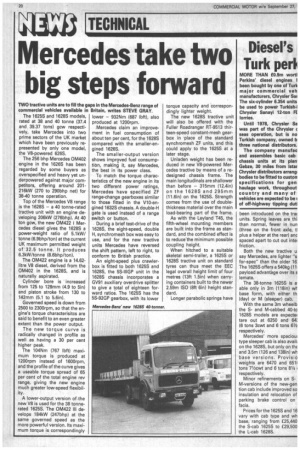Mercedes take two big steps forward
Page 22

If you've noticed an error in this article please click here to report it so we can fix it.
TWO tractive units are to fill the gaps in the Mercedes-Benz range of commercial vehicles available in Britain, writes STEVE GRAY.
The 16255 and 1628S models, rated at 38 and 40 tonne (37.4 and 39.37 tons) gcw respectively, take Mercedes into two prime sectors of the UK market which have been previously represented by only one model, the V8-powered 6265.
The 256 bhp Mercedes 0M402 engine in the 16265 has been regarded by some buyers as overspecified and heavy yet underpowered against major competitors, offering around 201216kW (270 to 290bhp net) for 38-40 tonne operation.
Top of the Mercedes V8 range is the 1628S — a 40 tonne-rated tractive unit with an engine developing 206kW (276bhp). At 40 ton gcw, the new 0M422 I Mercedes diesel gives the 16285 a power-weight ratio of 5.1kW/ tonne (6.9bhp/ton) at the current UK maximum permitted weight of 32.5 tonne. It produces 6.3kW/tonne (8.6bhp/ton).
The 0M422 engine is a 14.62litre V8 diesel, derived from the 0M402 in the 1628S, and is naturally aspirated.
Cylinder bore is increased from 125 to 128mm (4.9 to Sin) and piston stroke from 130 to 142mm (5.1 to 5.6in).
Governed speed is down from 2500 to 2300rpm, so that the engine's torque characterisitcs are said to benefit to an even greater extent than the power output.
The new torque curve is radically changed in profile as well as having a 30 per cent higher peak.
The 104Nm (767 lbft) maximum torque is produced at 1200rpm instead of 1600rpm, and the profile of the curve gives a useable torque spread of 65 per cent of the total engine rev range, giving the new engine much greater low-speed flexibility.
A lower-output version of the new V8 is used for the 38 tonnerated 1625S. The 0M422 III develops 184kW (247bhp) at the same governed speed as the more powerful version. Its maximum torque is correspondingly lower — 932Nm (687 lbft), also produced at 1200rpm.
Mercedes claim an improvement in fuel consumption of about ten per cent, for the 1628S compared with the smaller-engined 1626S.
The smaller-output version shows improved fuel consumption, making it, say Mercedes, the best in its power class.
To match the torque characteristics of the new engine in its two different power ratings, Mercedes have specified ZF range-change gearboxes similar to those fitted in the V10-engined 16325 chassis. A double-H gate is used instead of a range switch or button.
During a brief test-drive of the 1628S, the eight-speed, double H, synchromesh box was easy to use, and for the new tractive units Mercedes have reversed the shift pattern, left to right, to conform to British practice.
An eight-speed plus crawlerbox is fitted to both 1625S and 1628S, the 5S-IIIGP unit in the 16285 chassis incorporates a GV91 auxiliary overdrive splitter to give a total of eighteen forward ratios. The 1625S has the 5S-92GP gearbox, with its lower torque capacity and correspondingly lighter weight.
The new 1628S tractive unit will also be offered with the Fuller Roadranger RT-9513 thirteen-speed constant-mesh gearbox in place of the standard synchromesh ZF units, and this could apply to the 1625S at a later stage.
Unladen weight has been reduced in new V8-powered Mercedes tractive by means of a redesigned chassis frame. The main longitudinals are shallower than before — 315mm (12.4in) on the 1 6 2 8S and 2 9 5mm (11.6in) on the 1625S. Strength comes from the use of doublethickness material over the main load-bearing part of the frame.
As with the Leyland T45, the fifth-wheel mounting members are built into the frame as standard, and the combined effect is to reduce the minimum possible coupling height.
When hitched to a suitable skeletal semi-trailer, a 1625S or 1628S tractive unit on standard tyres can thus meet the EEC legal overall height limit of four metres (13ft 1.5in) when carrying containers built to the newer 2.59m ISO (8ft 6in) height standard.
Longer parabolic springs have




























































































































